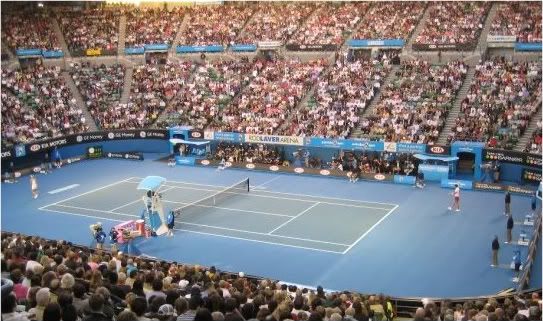Over the last year some of Australia’s media heavyweights have fought a high-stakes battle over the television rights to sports coverage. In one corner was ASTRA, the Australian Subscription Television and Radio Association (chaired by ex-Victorian ALP Premier Steve Bracks), most of the major Australian sports associations and Fox Sports. In the opposing corner were Free TV Australia (representing all of Australia's commercial free-to-air television licensees including channels Seven, Nine and Ten) and the Keep Sport Free campaign (chaired by ex-Queensland ALP Premier Wayne Goss). The referee was the Federal Communications Minister Stephen Conroy.
According to Conroy his job was to ensure a balance between the two sides. The only problem is that you would think his actual job as an elected representative would be to push a third agenda - that of the Australian people. Considering 70% of Australian people do not have pay TV, surely someone should be putting in a few right hooks for us. As predicted, Conroy achieved a balance between the giant media powers managing to give both sides a large purse for just turning up.
The bout was to be contested over a list of sporting events. A short but powerful list which dictates the sports events that must be offered to free-to-air networks before the pay TV networks. If the free-to-air networks decide not to bid for these rights twelve weeks prior to the event, pay TV networks are able to bid. The list was introduced by the Keating Government in 1994 to stop pay TV networks from exclusively obtaining the rights for major sporting events and siphoning them off from free-to-air TV. Anti-siphoning has generally been seen as a socially responsible scheme to ensure major sports events are accessible to people who can not afford pay TV.
Kerry Packer was one of the driving forces behind efforts to introduce the scheme in the first place and while social responsibility was a concomitant consequence, the scheme was also a huge win for the free-to-air commercial networks. They have benefited greatly from the anti-siphoning rules, enabling them to win the rights for valuable sporting events at a lower price. Hence the opposition by the sports associations who believe they will be able attract higher bids for their product if the market is opened up to pay TV. However, it is extra money that they could lose on sponsorships if broadcasting is restricted to a smaller audience.
Every few years the anti-siphoning list is reviewed. The current list expires on 31 December 2010 and a decision is expected to be finalised in the new year.
Throughout 2010 the stakeholders weaved, ducked and lobbied their way around the ring with a few pitty-pat punches from Goss and Bracks. Then suddenly some of the prize fighters changed sides part way through. Media tycoons James Packer and Lachlan Murdoch started off in the pay TV corner - both owning significant shares in Foxtel through their respective companies. In October 2010 news broke that Packer had acquired an 18% share in Channel Ten (which runs the free-to-air digital sports channel One HD). Packer then sold half of his shares to Murdoch and both have since accepted seats on the Channel Ten board. In the few weeks after this announcement Conroy released his review on the anti-siphoning scheme, “Sport on Television” outlining his plans for a two tier system to allow free-to-air-channels to use their digital channels to broadcast listed events for the first time. This was a huge win for the free-to-air networks, particularly Channel Ten who has the only digital all sports channel. Victory is sweet for the billionaires who now also profit from this decision.
Murdoch also owns 9% of the regional Prime Network and one of Packer’s closest friends, David Gyngell runs Nine. So this group of rich mates had media in Australia all wrapped up nicely in time for Christmas.
It seems that Stephen Conroy, far from being the independent referee, has been trying out to be corner man for the billionaire mates. Conroy did nothing to stop the blatant conflict of interest in the Channel Ten Murdoch-Packer deal (given they also own significant shares in One HD’s only competitor in the Australian market, Fox Sports). In the anti-siphoning review, Conroy announced that he intended to remove thirteen sports events from the anti-siphoning list and add only three. That is thirteen more events able to be siphoned off to pay TV. The list includes the French Open tennis, early rounds of Wimbledon, netball games played by Australia outside Australia, some rugby test matches and some rugby league test matches.
If you’re wondering where the ABC’s role is in all of this then don’t look at Conroy for a backbone. His review took little notice of the ABC’s submission, treating them like a palooka. The review rejected the notion the ABC put forward that communications laws should support under-promoted sports such as women’s sport and the Paralympics. No changes proposed in the review favour the ABC or SBS. If funded properly these networks could further assist in ensuring a wide variety of sports are broadcast live rather than the Australian public being saturated with AFL, NRL and cricket. Instead, Conroy committed $250 million to Seven, Nine and Ten in February this year to top up their profits.
Unfortunately the future looks no brighter for sports viewers as we see a shorter anti-siphoning list to take us through the next few years. A number of sports will either continue to be shown on expensive pay TV channels with little chance of becoming more accessible or taken from free-to-air and shown on pay TV. All this as part of an Australian media which has a more concentrated ownership than ever. As you’d expect when opposing teams and the referee join forces part way through the match, the fans won’t get much of a show.
Wednesday, December 29, 2010
Subscribe to:
Posts (Atom)
 RSS Feed
RSS Feed Twitter
Twitter



